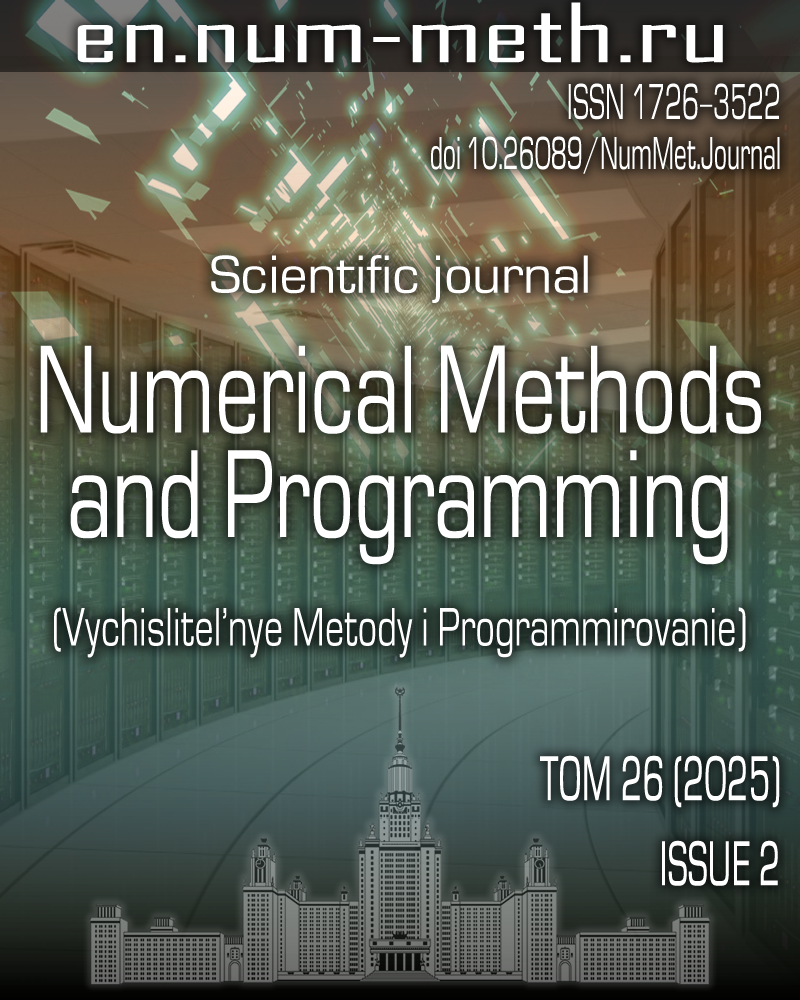DOI: https://doi.org/10.26089/NumMet.v26r211
On the computation of higher derivatives of analytic functions
Keywords:
analytic function
higher-order derivative
Cauchy integral formula
discrete Fourier transform
fast Fourier transform
interpolation Lagrange polynomial
residual term of the interpolation formula
Abstract
The representation of the derivative of an analytic function as a discrete Fourier transform with a residual term is found using the Cauchy integral formula. The estimation of the residual term is given. An example of joint use of the obtained formula and a standard computer program, in which the algorithm of fast Fourier transform is implemented, for different number of discrete samples is considered.
Published
2025-04-22
Issue
Section
Methods and algorithms of computational mathematics and their applications
References
- A. F. Albu, A. Yu. Gorchakov, and V. I. Zubov, “FAD Technique and Differentiation of a Composite Function,” Zh. Vychisl. Mat. Mat. Fiz. 63 (1), 61-73 (2023) [Comput. Math. Math. Phys. 63 (1), 57-68 (2023)].
doi 10.1134/S0965542523010037 - N. D. Kuzmichev, “Numerical Methods for Finding Higher Derivatives Using Discrete and Fast Fourier Transform,” in Proc. XIV Int. Scientific Conf. on Differential Equations and Their Applications in Mathematical Modeling, Saransk, Russia, July 9-12, 2019.
https://conf.svmo.ru/files/2019/ProceedingsSaransk2019.pdf. - G. Lantoine, R. P. Russell, and T. Dargent, “Using Multicomplex Variables for Automatic Computation of High-Order Derivatives,” ACM Trans. Math. Softw. 38 (3), Article 16, 1-21 (2012).
doi 10.1145/2168773.2168774 - H. R. Millwater and S. Shirinkam, “Multicomplex Taylor Series Expansion for Computing High-Order Derivatives,” Int. J. Appl. Math. 27 (4), 311-334 (2014).
doi 10.12732/ijam.v27i4.2 - A. M. Aguirre-Mesa, M. J. Garcia, and H. Millwater, “MultiZ: A Library for Computation of High-Order Derivatives Using Multicomplex or Multidual Numbers,” ACM Trans. Math. Softw. 46 (3), 1-30 (2020).
doi 10.1145/3378538 - A. N. Gromov, “On Koenig’s Theorem for Integer Functions of Finite Order,” Numerical Methods and Programming textbf 21 (3), 280-289 (2020).
doi 10.26089/NumMet.v21r324 - A. N. Gromov, “A Globally Convergent Method for Finding Zeros of Integer Functions of Finite Order,” Numerical Methods and Programming textbf 18 (2), 115-128 (2017).
doi 10.26089/NumMet.v18r209 - J. N. Lyness and C. B. Moler, “Numerical Differentiation of Analytic Functions,” SIAM J. Numer. Anal. textbf 4 (2), 202-210 (1967).
- A. I. Markushevich, Theory of Analytic Functions, Vol. 1 (Nauka, Moscow, 1967; Chelsea, New York, 1977).
- I. S. Berezin and N. P. Zhidkov, Computing Methods(Nauka, Moscow, 1962; Oxford, Pergamon, 1965).
- N. S. Bakhvalov, N. P. Zhidkov, and G. M. Kobelkov, Numerical Methods(BINOM, Moscow, 2011) [in Russian].
- G. I. Marchuk, Methods of Computational Mathematics(Nauka, Moscow, 1980; Springer, New York, 1982).
- I. I. Ibragimov, Function Interpolation Methods and Some of Their Applications(Nauka, Moscow, 1971) [in Russian].
- G. M. Fichtenholz, Course of Differential and Integral Calculus, Vol. 2 (Nauka, Moscow, 1972) [in Russian].
- D. V. Kiryanov, Mathcad Tutorial 11(BHV-Petersburg, St. Petersburg, 2003) [in Russian].
License
Copyright (c) 2025 А. Н. Громов

This work is licensed under a Creative Commons Attribution 4.0 International License.


